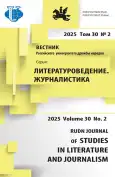Rachel Carson’s Silent Spring: A Plea for Changing Environmental Policy
- Авторлар: Neupane R.1, Verkhoturov V.V.2
-
Мекемелер:
- Tribhuvan University
- Kaliningrad State Technical University
- Шығарылым: Том 30, № 2 (2025)
- Беттер: 298-309
- Бөлім: LITERARY CRITICISM
- URL: https://journal-vniispk.ru/2312-9220/article/view/319129
- DOI: https://doi.org/10.22363/2312-9220-2025-30-2-298-309
- EDN: https://elibrary.ru/JGLRKM
- ID: 319129
Дәйексөз келтіру
Толық мәтін
Аннотация
Analyzes how Rachel Carson’s 1962 book Silent Spring significantly influenced the Change in Environmental Policy. Historically, when academics talk about attempts to change environmental policy, they primarily focus on the contributions of natural and social scientists who assess the effects of pollution and other harmful factors on the environmental response to the increased use of pesticides in the 1960s, Carson produced her cross-disciplinary book, which combined environmental science and narrative. Silent Spring was able to influence and start changes in the laws governing chemical insect control and the outlawing of the synthetic pesticide DDT (dichloro-diphenyl-trichloroethane). By challenging the conventional wisdom that viewed man as the master and master of nature, Carson’s book changed policy and inspired new research, demonstrating that the overuse of pesticides is both dangerous and immoral. Her book is considered a founding work of the contemporary environmental movement. The links between science, literature, and public participation that have the potential to increase public understanding of the significance of environmental literature as a tool for influencing environmental policy is the issue this paper has explored in the novel. Applying qualitative research design, this article critically examines and analyzes the environment from a crossdisciplinary approach, using Silent Spring as an exemplary case of a literary text that can affect environmental policy, both in the academic and, more crucially, in real life. Lawrence Buell’s critical insights on the environmental realities that the text portrays serve as a theoretical perspective to analyze the novel.
Негізгі сөздер
Авторлар туралы
Ravindra Neupane
Tribhuvan University
Email: epedagogy@mail.ru
ORCID iD: 0009-0005-9180-9255
PhD in Philology, Associate Professor at the Department of English
Ratna Rajyalaxmi Campus, Kirtipur, Kathmandu, 44613, NepalVasily Verkhoturov
Kaliningrad State Technical University
Хат алмасуға жауапты Автор.
Email: epedagogy@mail.ru
ORCID iD: 0000-0003-2979-9867
Grand PhD in Pedagogy, Professor at the Department of Pedagogy
1 Sovetsky Prospekt, Kaliningrad, 236022, Russian FederationӘдебиет тізімі
- Bryson, M.A. (2003). Nature, Narrative, and the Scientist-Writer: Rachel Carson’s and Loren Eiseley’s Critique of Science. Technical Communication Quarterly, 12(4), 369–387. https://doi.org/10.1207/s15427625tcq1204_2
- Buell, L. (2005). The Future of Environmental Criticism. Blackwell.
- Carlo, G.L. (2000). Radio waves, wireless signals, and public health: Is this the next silent spring? Environmental Claims Journal, 12(4), 55–77. https://doi.org/10.1080/ 10406020009355139
- Carson, R. (1962). Silent Spring. Houghton.
- Gartner, C.B. (2000). When Science Writing Becomes Literary Art: The Success of Silent Spring. In C. Waddell (Ed.), And No Birds Sing: Rhetorical Analysis of Rachel Carson’s Silent Spring (pp. 103–225). Southern Illinois UP.
- Gay, H. (2012). Before and After Silent Spring: From Chemical Pesticides to Biological Control and Integrated Pest Management – Britain, 1945–1980. Ambix, 59(2), 88–108. https://
- doi.org/10.1179/174582312X13345259995930
- Gore, A. (1962). Introduction. Silent Spring. By Rachel Carson. Houghton Mifflin.
- Graham, F.Jr. (1970). Since Silent Spring. Houghton.
- Gunter, V.J. (2005). News Media and Technological Risks: The Case of Pesticides after Silent Spring. The Sociological Quarterly, 46(4), 671–698. https://doi.org/10.1111/
- j.1533-8525.2005.00031.x
- Killingsworth, J.M., & Jacqueline, P.S. (2000). Silent Spring and Science Fiction: An Essay in the History and Rhetoric of Narrative. In Craig Waddell (Ed.), And No Birds Sing: Rhetorical Analyses of Rachel Carson’s Silent Spring (pp. 174–204). Southern Illinois UP.
- Lytle, M.H. (2007). The Gentle Subversive: Rachel Carson, Silent Spring, and the Rise of the Environmental Movement. Oxford UP.
- Massey, A. (2021). Editorial: Silent Spring: can we fix wicked problems? Public Money & Management, 42(2), 53–54. https://doi.org/10.1080/09540962.2022.2003595
- McCay, M.A. (1993). Rachel Carson. Twayne.
- Meyer, C.A. (2021). Taking Lessons from Silent Spring: Using Environmental Literature for Climate Change. Literature, 1(1), 2–13. https://doi.org/10.3390/literature1010002
- Montefiore, J. (2001). ‘The fact that possesses my imagination’: Rachel Carson, Science and Writing. Women: A Cultural Review, 12(1), 44–56. https://doi.org/10.1080/
- Murphy, M.K. (2018). Scientific argument without a scientific consensus: Rachel Carson’s rhetorical strategies in the Silent Spring debates. Argumentation and Advocacy, 55(3), 194–210. https://doi.org/10.1080/00028533.2018.1429065
- Murphy, M.K. (2024). Sublime Wonder: Rachel Carson, Nature Writing, and Human-Nature Connection. Western Journal of Communication, 1–20. https://doi.org/10.1080/10570314.2024.2366213
- Papers of John F. Kennedy. (1963, May 15). Presidential Papers. President’s Office Files. Departments and Agencies. President’s Science Advisory Committee (PSAC): Pesticides report.
- Savory, E. (2024). Rachel Carson’s Strategies for Literary Science and Silent Spring. Environment: Science and Policy for Sustainable Development, 66(3), 26–36. https://doi.org/10.1080/00139157.2024.2319633
- Wills-Toker, C. (2003). The Environmental Rhetoric of Rachel Carson. Review of Communication, 3(3), 293–296. https://doi.org/10.1080/0308407
Қосымша файлдар









